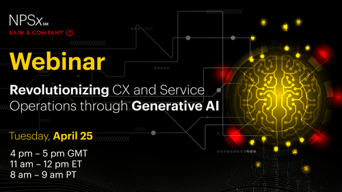
Bain experts explain how new AI tools can revolutionize CX and service operations.
We’ve entered a new age of artificial intelligence (AI). With breakthroughs in computing, brands can leverage massive amounts of data to create original content.
In our recent NPSx webinar, Bain Partners Jeff Katzin and Rob Levy explained how generative AI is different from former applications and how brands can use large language models to transform customer interactions responsibly.
Here are the highlights:
What’s new in AI
AI hit a tipping point in two big ways: It became widely available for many individuals, and the technology evolved to become generative.
Traditional AI focused on discrete tasks or problems, and it relied on algorithms and structured data to make predictions. The tools we’re talking about today can analyze much wider data sets, including structured and unstructured data from up and down the technology stack. Today’s AI doesn’t just analyze, it creates. What’s really unique is its ability to integrate information across the technology stack. That will be revolutionary for CX and service operations.
Generative AI is more than ChatGPT
Most people know of ChatGPT, which uses prompts to create new content. But text generation is only one natural language capability. Generative AI can also translate text from one language to another, classify information, detect sentiment, summarize dialogue, and generate conversational responses.
In the CX world, one real-world application is customer verbatims. In the past, someone would read hundreds of customer verbatims or create bespoke code to process them. Now, you can feed customer feedback from multiple modalities into a generative AI tool. In seconds or minutes, it can synthesize the comments, organize them into categories or themes, and summarize everything in a really natural way.
You can also apply generative AI in your chat interface or call center to close the loop with customers. After an interaction, AI can write an email that summarizes the contact request, suggests some resolutions, and includes an image or how-to guide to troubleshoot the incident.
Generative AI can provide recommendations to live support service agents, too. One Fortune 500 company is using AI to monitor customer chats and “coach” agents. In short order, AI boosted worker productivity by 14%, on average, and improved worker performance.
Examples of generative AI in action
Hundreds, if not thousands, of enterprises are starting to deploy the technology, from marketing to internal operations. Just a snapshot:
Coca-Cola is using ChatGPT functionality and Dall E in a marketing application. It invited customers to create unique Coca-Cola artwork with the tools, and you can see the results on Times Square in New York or Piccadilly Circus in London.
Morgan Stanley is using the technology with their wealth advisors. It’s embedding generative AI into a desktop application to integrate search, communication, and customer responses.
Instacart and Spotify have embedded the technology into their applications, too. Instacart is using generative components to suggest recipes based on a customer’s shopping list, while Spotify created a personalized DJ for listeners. It curates a personalized listening experience, so the interaction is more immersive and personal.
These examples illustrate two operational approaches. On one hand, companies are embedding AI into existing products to create a distinct customer experience. Others are using AI to improve customer experience applications, marketing applications, internal efficiency and operations.
Prioritize the benefits of generative AI
Naturally, companies want to know where to start. It boils down to the benefit. You have to figure out what generative AI can afford the business.
Could you accelerate growth by getting the right offer and message to the right individual customers? Could it get you to market faster or make workers more efficient? Can you create a customer experience that feels intuitive and connected?
There are AI applications for each of these goals. There are dozens of uses cases across marketing, sales, customer service, loyalty, customer insight, and operations. Companies that are gaining the fastest traction with AI are thinking about how the technology ladders up to their existing priorities. Those use cases are most likely to get funding and leadership alignment.
It’s not a shiny tool. Figure out how to use generative AI for customer experience to serve customers and employees better. Prioritize where and how to use generative AI based on the value it could bring to customers and employees.
Ethics and corporate responsibility
Companies that leverage generative AI for customer experience can accelerate growth, transform costs, and increase their Net Promoter Scores. But they need to balance their goals and innovation in a responsible way.
You need processes and guardrails around content that’s being created by AI. For some companies, that means limiting the inputs to publicly available data to protect personally identifiable information. For other companies, it’s exactly the opposite. They only generate material from content they own, know, and trust. You can restrict generative AI apps to special data lakes for machine learning, or require a human overlay, where a human has to touch content before it’s used.
There are real risks involved. Industries are regulated differently, and that should affect how you rank uses cases. Be aware of the risks and how to manage them as you begin.
Companies can use generative AI to create more dynamic and personalized customer interactions – with far less effort. If you want to use generative AI for customer experience strategy or contact centers, start here. NPSx from Bain & Company can keep you at the forefront of innovation.


